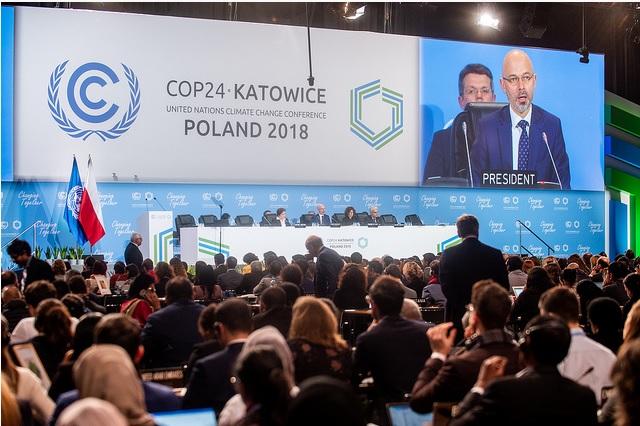Is Gender-Just Climate Action Possible Without Equity?

Image Courtesy: cop24.gov.pl
The crowds at this year’s annual UN climate summit at Katowice in Poland (December 2-14) were no different from the ones at previous editions of the summit over the last several years -- participants were not only from the official country, but included academics, consultants, activists, and representatives from various non-governmental organisations or other powerful lobby groups, such as corporate think-tanks, businesses and business groups, to name only the most visible.
Each such section brought their own perspective to climate change and following from that, a whole range of specific issues and interests. Gender was one of the prominent ones among such perspectives represented at these summits – and, of course, most definitely progressive in contrast to the many others that were also represented.
Indeed, from its initial status as a perspective outside the official one, gender has moved to being a serious mainstream concern. At the 2017 edition of the summit at Bonn, the Gender Action Plan was officially established and efforts to mainstream gender in climate action through official channels of the UNFCCC (United Nations Framework Convention on Climate Change) have begun in earnest since then.
From the first day of this year’s conference, a number of events on the issue of gender equality and gender-responsive climate action were organised and conducted with much success. December 11 was declared as “Gender Day” and events on various aspects of climate change mitigation, adaptation, and finance discussed through the perspective of gender justice were organised throughout the day, not just as side events but also as part of the “high level” segment of the UNFCCC. One, of course, should not downplay or underestimate the effort required by women getting together in a variety of ways to get to this stage, but some success has certainly been obtained.
Apart from such official events and other discussions and so on held by the non-government sections at the summit, there is also the obvious matter of diversity and representation among the official and non-official participants at the summit itself. To the casual eye, diversity at the conference could be made out only to the extent that obvious markers allow, but one can confidently say that it was not an event dominated by men. Many women, not just from the global North, but also from the global South were part of the plenaries, official events, side events, and other goings on at the conference.
Women constituted a significant proportion of many official delegations of developed and developing countries. The exception on this score amongst the big players at the negotiations was, somewhat predictably, India. We had a smaller delegation compared with many other developing countries, but one that was sorely lacking in diversity. This is an issue that India needs to address seriously, sooner rather than later. But apart from these few exceptions, it definitely seems as if gender mainstreaming is well on its way to being counted as one of the relative success stories in introducing a progressive narrative in the climate arena.
There is, however, a puzzle here of quite significant proportions, a question that seems like the elephant in the room. How does gender and the ideal of gender equity make it to mainstream status while equity as a whole takes a backseat in the negotiations and seems forever in the danger of falling off the agenda altogether?
Indeed, it is the very weakness of the scope of climate mitigation by the global North that seems to strike the first blow against equity. Their political leaders urge climate action commensurate to meet the ambitious global goal of restricting temperature rise to below 1.5 deg. C, agreed to, at least as a desirable one, in Paris.
However, one of the largest emitters of carbon dioxide in cumulative terms, the United States, continues to stand by its decision to withdraw from the Paris Agreement. Other developed countries, such as Germany and Russia, are speedily putting up new infrastructure for the former to purchase gas from the latter, while pursuing deals for gas exploration in their own regions. Scientists from these countries, while pushing the agenda of a 1.5 deg. C target for limiting global temperature rise, refused to address the question of its feasibility, the target being well-nigh impossible given the highly inadequate effort in climate change mitigation in their own countries. Their economists continued to argue for the withdrawal of energy subsidies for the poor in the developing countries. International NGOs and think-tanks also continue to ignore the inaction of their home countries and remain focused on how immediate mitigation may be forced on developing countries in the name of “co-benefits”.
All the push for direct climate mitigation action in developing countries comes in the background of the latter’s continuing and massive burden of socio-economic vulnerability, much of whose origins lie in conditions that predate any environmental impact attributable to climate change. India is a striking example in this regard. Take, for example, the number of people directly dependent on agriculture – which is about 59% of the total workforce -- either as cultivators (32%) or agricultural labourers (27%). Among cultivators, 71% of the total number of landholdings are less than two hectares in size, although this makes up for only 6% of the total land under agricultural cultivation. This means that a large number of people are dependent on low-value agricultural production, based largely on non-irrigated, rain-fed cultivation with low value of modern inputs.
At the same time, roughly the same section of the population has little or no access to modern energy, infrastructure and services. Only 56% of the total households in India have access to electricity, only 39% have connections for safe drinking water within the premises of their house, and only 18% of the households have access to modern cooking fuels such as LPG (liquefied petroleum gas) or CNG (compressed natural gas).
Women, the constituency ostensibly under focus at the climate negotiations, bear the brunt of this large-scale rural backwardness and the lack of access to modern and clean fuels and amenities. This is in addition to bearing the burdens of low incomes, lack of employment opportunities, and low levels of participation in formal economic activity. And it is this same section that is particular vulnerable to the impact of climate change, to the disasters that follow extreme events, and to the threat of sea-level rise in the poor communities that populate the coastlines of the global South.
When developed countries refuse to accept that equity in climate action is fundamental to the transition to a safer world in a just manner, when they seek to sideline the adaptation agenda, when they drag their feet on climate finance and refuse to entertain any serious support to loss and damage, they directly undermine the interests of the most vulnerable sections of the world’s population, and foremost among them, poor women in developing countries.
So, when the representatives and spokespersons from the global North adopt the language of gender-just climate action, one is forced to wonder if this is simply a red herring, meant to divert attention from the fact that countries, where the most vulnerable among this constituency reside, will be left bearing the burden of climate change mitigation and adaptation. What is the significance of the apparent success in mainstreaming the gender narrative in climate negotiations when it is accompanied by an all-round attempt to subvert an equitable and just solution to climate change?
While women everywhere, as individuals, collectives and movements are vitally interested in the gender dimension of climate action receiving its due, they must ask themselves these crucial questions. Are they being fobbed off by the tokenism of discourse and representation, while the substance and material basis of gender justice are being undermined in the manner in which the future of global climate action is being shaped? Without putting their considerable weight behind the fight for overall equity and climate justice can women seriously hope to achieve true gender justice in practice?
(The writer is Assistant Professor, Tata Institute of Social Science, Mumbai, and Chairperson, Centre for Climate Change and Sustainability Studies, School of Habitat Studies. The views expressed are personal.)
Get the latest reports & analysis with people's perspective on Protests, movements & deep analytical videos, discussions of the current affairs in your Telegram app. Subscribe to NewsClick's Telegram channel & get Real-Time updates on stories, as they get published on our website.























